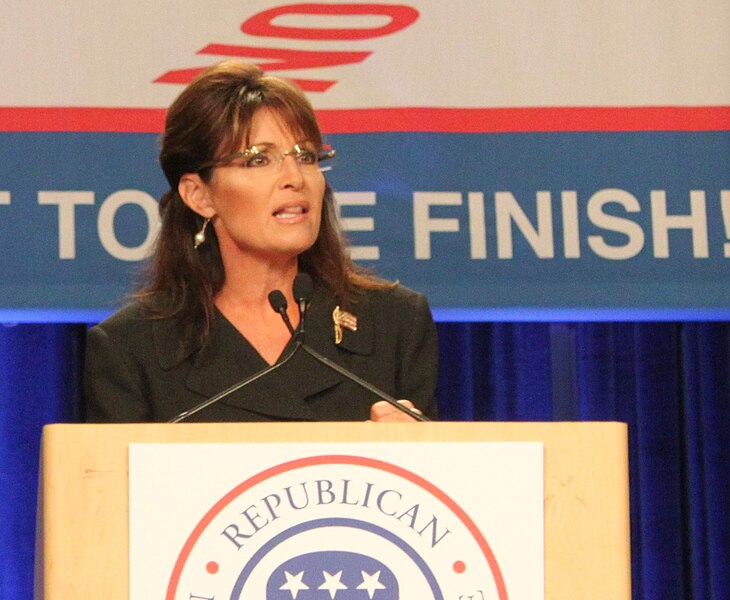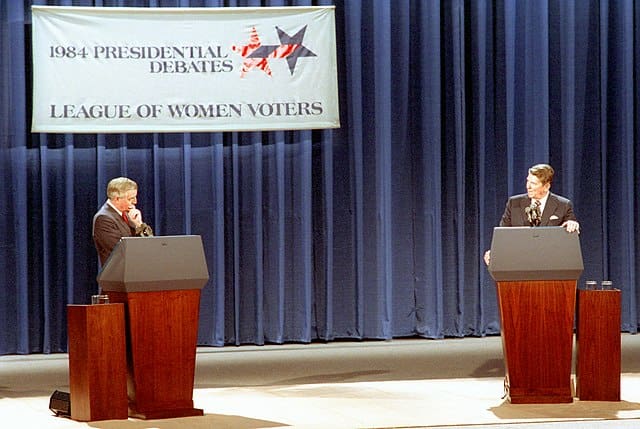US Presidential Debates: 20 Memorable Moments and Their Impact
As a student of politics with a keen interest in US presidential elections, I have followed my fair share of pivotal debate moments. When candidates face off on the debate stage, the stakes are incredibly high. One small gaffe or witty quip can shape the narrative around a campaign, garner headlines for days, and even swing the polls.
In this article, I’ll draw from my experience of presidential debates to recap 20 of the most unforgettable moments that left an indelible mark. From Ronald Reagan‘s iconic “There you go again” jab at Jimmy Carter to Donald Trump lurking creepily behind Hillary Clinton, many of these instances captured the mood and spirit of their time.
Even years or decades later, these instances offer insight into candidates’ temperaments or key issues that decided a close election. Whether puzzling or simply amusing, these are the 20 presidential debates that remain etched in America’s collective memory.
1. The Nixon-Kennedy Showdown (1960): The Birth of Televised Debates
In the first-ever televised presidential debate, John F. Kennedy and Richard Nixon faced off, revolutionizing the political landscape. Kennedy’s poise and charisma shone, marking a new era where visual impact mattered as much as words. This transformative event not only shifted the dynamics of political communication but also laid the foundation for the modern spectacle of presidential debates.
The introduction of television brought candidates into people’s living rooms, emphasizing the significance of image and demeanor. Kennedy’s ability to leverage this visual medium showcased a keen understanding of the evolving nature of political communication, forever altering how candidates engage with the electorate.
2. Gerald Ford’s Debate Gaffe (1976): A Factual Misstep
Gerald Ford’s assertion that Eastern Europe was not under Soviet dominance raised eyebrows, highlighting the significance of factual accuracy in these high-stakes debates. Ford’s factual misstep became a cautionary tale, emphasizing the critical importance of being well-versed in global affairs and avoiding factual errors that can erode credibility.
This moment serves as a reminder that in the realm of presidential debates, where the world is watching, every word carries weight, and inaccuracies can reverberate far beyond the debate stage. It underscored the need for presidential candidates to possess a comprehensive understanding of international relations, ensuring that their statements withstand scrutiny and contribute to a well-informed electorate.
3. Reagan’s Memorable Debate Quip (1984)
“I am not going to exploit, for political purposes, my opponent’s youth and inexperience.”
In the second presidential debate with Democratic candidate Walter Mondale, Ronald Reagan’s wit disarmed critics and showcased his humorous side, turning a potentially offensive topic into a moment of comedic brilliance. This memorable quip not only highlighted Reagan’s quick thinking but also set a precedent for candidates to use humor strategically, injecting levity into high-stakes political confrontations.
The enduring impact of Reagan’s clever retort remains a testament to the art of political rhetoric and its ability to shape public perception. Reagan’s quip demonstrated that humor, when wielded judiciously, could not only entertain but also convey a subtle message about the strength and character of a candidate, making it a powerful tool in the political arsenal.
4. Dukakis’s Emotionless Response (1988): A Lack of Empathy

George Bush Presidential Library and Museum, Public domain, via Wikimedia Commons
Michael Dukakis‘s stoic response to a hypothetical question about his wife’s assault showcased a lack of emotional connection, contributing to his electoral downfall. Dukakis’s seemingly emotionless response not only fueled perceptions of detachment but also raised questions about the ability of candidates to convey empathy in the face of personal tragedy.
This moment became a cautionary tale about the importance of connecting with voters on an emotional level, emphasizing that political leadership requires not only policy acumen but also the capacity to resonate with the human experiences of the electorate. Dukakis’s emotional disconnect influenced narratives about the role of empathy in political leadership.
5. Quayle vs. Benson (1988): Potato or Potatoe
Dan Quayle‘s misspelling of “potato” during a school visit became a humorous and unforgettable moment, overshadowing the substance of the debate. This linguistic misstep not only drew attention to Quayle’s spelling prowess but also became a symbol of the scrutiny candidates face on even the minutest details. The potato debacle became a defining moment in the 1988 vice-presidential debate.
It prompted discussions about the importance of linguistic precision and the role of trivial incidents in shaping public perceptions. Quayle’s misspelling underscored the high-stakes nature of political communication and the enduring impact of seemingly inconsequential moments in the unforgiving arena of a televised debate.
6. Bush’s Glances at his Watch (1992): a Costly Distraction
George H.W. Bush‘s glance at his watch during a town hall debate in a 1992 presidential debate with Bill Clinton and Ross Perot. To many it signaled disinterest, reinforcing the importance of candidates’ body language in connecting with voters. This seemingly small gesture spoke volumes about the perception of engagement and attentiveness.
Bush’s inadvertent display of detachment highlighted the scrutiny candidates face not just for their words but also for their non-verbal cues. The watch glance served as a stark reminder that in the unforgiving spotlight of a debate, every gesture, no matter how subtle, can influence public opinion and shape the narrative of a candidate’s suitability for the highest office.
7. Perot’s Charts during a Debate (1992): The Power of Visual Aids
Ross Perot’s use of charts and graphs to explain complex economic issues demonstrated the impact of visual aids in simplifying intricate policy discussions. Perot’s strategic use of visuals not only clarified his policy positions but also highlighted the effectiveness of leveraging visual aids to connect with a diverse audience.
This moment served as a masterclass in translating complex ideas into accessible formats, emphasizing the role of visual storytelling in engaging voters and demystifying complex policy issues. Perot‘s innovative approach underscored the enduring power of visuals in the evolving landscape of political communication.
8. The Town Hall Debate of 1992: Clinton Connects with the People
Bill Clinton won the Town hall presidential debate in Kentucky by engaging with one audience member. His empathetic response to a question about the recession resonated with voters, showcasing his ability to connect on a personal level during the town hall debate.
This moment transcended mere policy discussions, illustrating the profound impact of authenticity and relatability in winning the hearts of the electorate. Clinton’s ability to weave policy into a narrative of empathy and understanding set a standard for future candidates, emphasizing the human side of leadership in the quest for public trust.
9. Gore’s Sighs (2000): A Breath Too Far
In the debate against George W. Bush, Al Gore‘s audible sighs became a symbol of frustration and, perhaps, cost him the presidency. This non-verbal communication spoke volumes about the pressure of the moment and the fine line candidates walk between conveying confidence and appearing condescending.
Gore’s sighs underscored the importance of not just what is said but how it is expressed, teaching future contenders the delicate balance between assertiveness and restraint in the intense crucible of a presidential debate. The audible frustration echoed beyond the words spoken, highlighting the challenges of maintaining composure and projecting a favorable image in the unforgiving scrutiny of a televised debate.
10. Sarah Palin’s Wink in the 2008

Neon Tommy, CC BY-SA 2.0, via Wikimedia Commons
Sarah Palin‘s winking at the camera during the vice-presidential debate became a symbol of her folksy charm but also raised questions about the seriousness of the occasion. Palin’s deliberate wink added a touch of personal charisma to her public image, resonating with some while raising eyebrows among others.
The memorable blink not only became a defining moment in Palin’s political persona but also sparked debates about the intersection of personality and political leadership. Palin’s winking moment highlighted the delicate balance candidates must strike between relatability and gravitas, underscoring the complexities of projecting authenticity in the scrutinized arena of a national debate.
11. Biden’s “Malarkey” (2012): A Folksy Zinger
Joe Biden’s use of the term “malarkey” injected a dose of colloquialism into the vice-presidential debate, emphasizing his relatability to the common voter. Biden’s folksy zinger not only added a touch of authenticity to his public image but also showcased his ability to connect with audiences on a personal level.
The use of colloquial language resonated with voters, humanizing Biden and setting him apart from more polished political rhetoric. This moment highlighted the strategic use of language in political communication, demonstrating that a well-chosen word can break through the noise of policy discussions and forge a direct connection with the electorate.
12. The Split Screen (2012): Romney and Obama’s Unspoken Battle
In the debate between Mitt Romney and Barack Obama, the split screen revealed the candidates’ reactions even when not speaking, offering viewers a unique insight into their unspoken responses. This innovative visual storytelling not only heightened the drama of the debate but also exposed the subtleties of candidates’ demeanor, adding a layer of authenticity to the televised spectacle. The split screen’s capacity to capture unguarded moments underscored the evolving nature of political communication in an era where the visual medium holds unparalleled sway over public perception.
13. Obama’s “Please Proceed” (2012): a Presidential Mic Drop
During the second debate against Romney, Barack Obama‘s “Please proceed, Governor” became a powerful comeback, epitomizing confidence in the face of criticism. Obama’s composed response not only deflected an attack but also showcased the art of political rhetoric and the strategic use of silence.
The “Please proceed” moment became a metaphorical mic drop, symbolizing the President’s ability to maintain composure under pressure and redirect the narrative in his favor. This instance highlighted the fine line candidates walk between assertiveness and restraint, showcasing the enduring power of a well-timed verbal riposte in the charged atmosphere of a presidential debate.
14. The Cold Open (2016): Trump vs. Clinton’s Intense Handshake …..
The visual intensity of Donald Trump and Hillary Clinton‘s handshake set the tone for a debate that would be remembered for its unprecedented animosity. This non-verbal exchange, loaded with tension, encapsulated the fierce rivalry between the candidates.
The handshake’s lasting impact lies in its ability to encapsulate the mood of the entire debate, serving as a symbolic precursor to the verbal sparring that would unfold. The power of this unspoken moment reverberated through the campaign, becoming a vivid snapshot of the polarized political climate that defined the 2016 presidential race.
15. …. The Looming Presence (2016): Trump’s Stalking Tactics

DonkeyHotey, CC BY-SA 2.0, via Wikimedia Commons
During the second presidential debate in 2016, Donald Trump‘s physical presence, often looming behind Hillary Clinton, added a layer of tension and drama to the proceedings. Trump’s strategic use of personal space became a spectacle that transcended mere political discourse. His constant pacing and positioning conveyed a deliberate attempt to unsettle his opponent and dominate the stage. The looming presence became a visual metaphor for the intense rivalry between the candidates.
This non-verbal strategy, though unconventional, highlighted the theatrical nature of modern political debates. It ignited debates not only on policy but also on the appropriateness of such tactics on the debate stage. Trump’s physicality in that moment reflected a unique approach to power dynamics, leaving a lasting impression on both political pundits and the public alike.
16. The Handshake Snub (2016): Trump vs. Cruz

Senator of Texas Ted Cruz. Michael Vadon, CC BY-SA 4.0, via Wikimedia Commons
In a display of political tension, Donald Trump notably snubbed Ted Cruz‘s attempt at a handshake during a Republican primary debate, revealing the internal party strife. The handshake snub became a vivid representation of the deep divides within the Republican Party during the 2016 primaries.
Trump’s refusal to shake hands with Cruz not only exposed the personal animosities between the candidates but also symbolized the broader fractures within the party. This unscripted moment underscored the interpersonal dynamics at play in political debates, offering a glimpse into the complexities of party politics and the challenges of maintaining unity in the face of internal discord.
17. Kamala Harris’s Moment (2020): “I’m Speaking”
In the vice-presidential debate, Kamala Harris‘s assertive “I’m speaking” moment became a rallying cry for many women, emphasizing the need for gender equality in political discourse. Harris’s unapologetic interruption highlighted the persistent challenges faced by female candidates in being heard and respected.
This assertive stance resonated with audiences, sparking conversations about the importance of equitable representation and setting a precedent for women to demand their rightful space in political discussions. Harris’s powerful moment transcended the debate stage, becoming a symbol of resilience and determination for women across the nation.
18. Healthcare Showdown (2020): Biden vs. Trump
The 2020 debates brought forth a fiery exchange between Joe Biden and Donald Trump on healthcare, highlighting the deep ideological divides in the nation. This moment encapsulated the broader policy clash between the two candidates and underscored the significance of healthcare as a central issue in American politics.
Biden and Trump’s intense debate over healthcare reform became a microcosm of the broader societal divisions, emphasizing the stakes at play and the contrasting visions for the future of the nation’s healthcare system. The healthcare showdown revealed the depth of policy differences and set the stage for a campaign defined by competing visions for the country’s future.
19. Warren’s Zinger (2020): “I have a plan for that.”
Elizabeth Warren’s consistent refrain, “I have a plan for that,” became synonymous with her policy-focused campaign, emphasizing the importance of concrete proposals. Warren’s repetitions not only encapsulated her reputation as a policy theorist but also set a standard for candidates to articulate clear and actionable plans. The repeated refrain became a rallying cry for Warren supporters.
It underscored the significance of substantive policy discussions in the electoral process. Warren’s commitment to detailed plans became a defining feature of her campaign, shaping narratives about the role of policy expertise and strategic planning in the realm of presidential debates.
20. The Fly (2020): Pence’s Unwanted Companion
The unexpected appearance of a fly on Mike Pence’s head during the vice-presidential debate spawned memes and provided a lighthearted distraction from the intense political discussions. Pence’s stoicism in the face of an uninvited insect became an unintentional moment of comic relief, reflecting the unpredictability of live events.
The viral nature of the fly incident demonstrated the enduring power of spontaneity and the internet’s ability to turn unexpected moments into cultural phenomena. Pence’s unwelcome companion highlighted the intersection of technology, humor, and political discourse in the digital age, showcasing how even the smallest and most incidental occurrences can leave a lasting impression on the public consciousness.
These memorable moments from US presidential debates have shaped political narratives, influenced voter perceptions, and, in some cases, altered the course of history. The stage is set for future debates to unfold, each one carrying the potential for another iconic moment that will be etched in the annals of American political discourse. The evolution of these debates reflects the dynamic nature of democracy, where words and actions on the debate stage reverberate through the corridors of power and into the hearts of the American people.
Planning a trip to Paris ? Get ready !
These are Amazon’s best-selling travel products that you may need for coming to Paris.
Bookstore
- The best travel book : Rick Steves – Paris 2023 – Learn more here
- Fodor’s Paris 2024 – Learn more here
Travel Gear
- Venture Pal Lightweight Backpack – Learn more here
- Samsonite Winfield 2 28″ Luggage – Learn more here
- Swig Savvy’s Stainless Steel Insulated Water Bottle – Learn more here
Check Amazon’s best-seller list for the most popular travel accessories. We sometimes read this list just to find out what new travel products people are buying.










